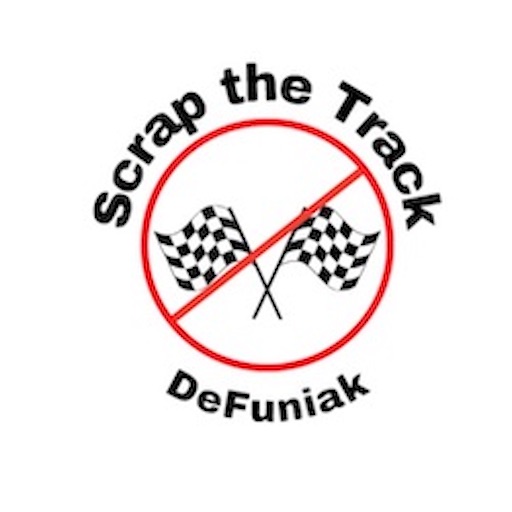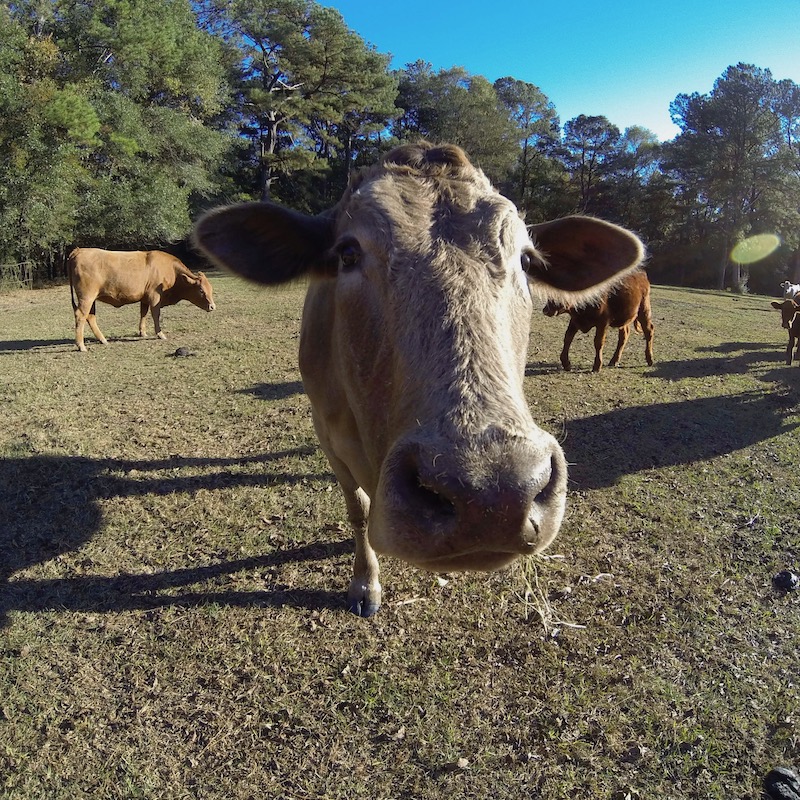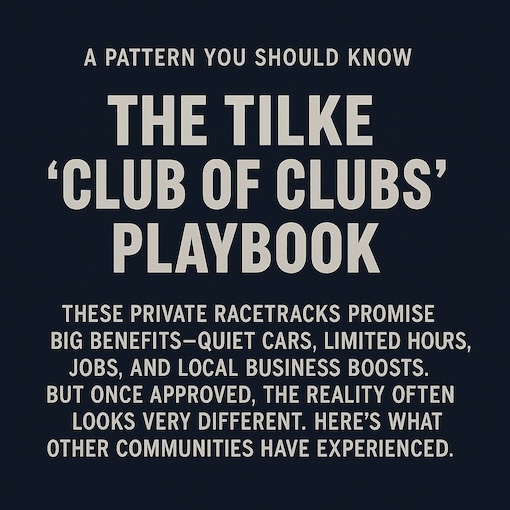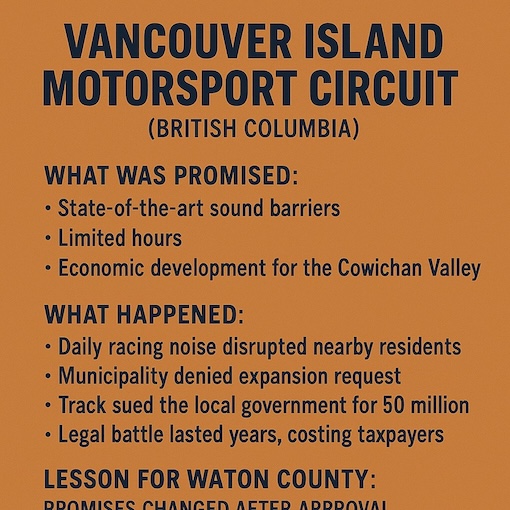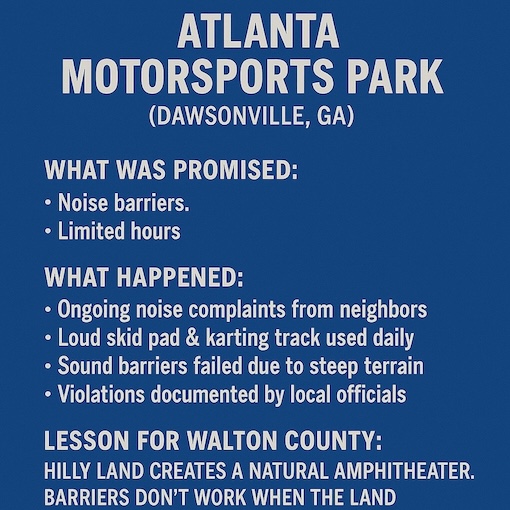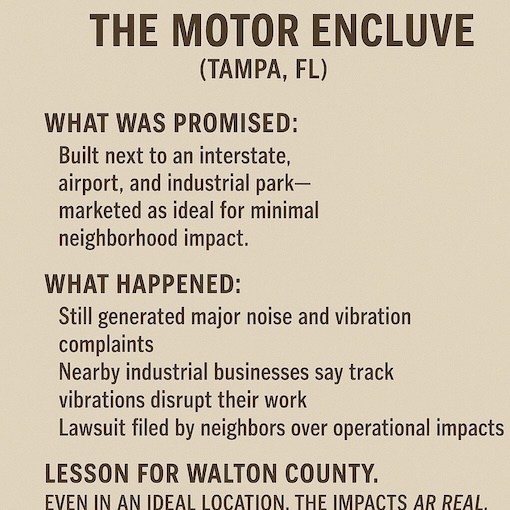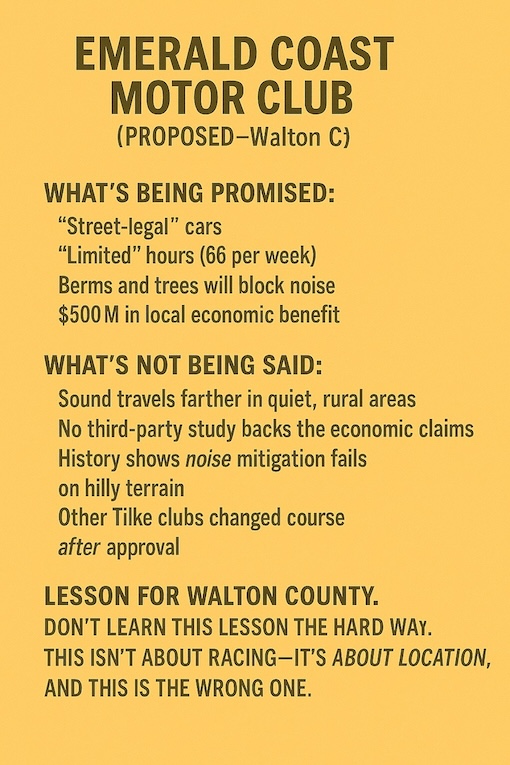Join Us to Scrap the Track
Why We Oppose Emerald Coast Motor Club
Many of us enjoy racing—and some of us are even racers ourselves.
We’re not against the idea of a private racetrack in Walton County. We’re against putting it in the wrong place.
This project would bring year-round unescapable racetrack noise, traffic, and environmental disruption to the quiet rural neighborhoods of Alaqua and Woodlawn in DeFuniak Springs. It simply doesn’t belong here.
Below, we break down the developer’s claims—and the serious concerns they’re not talking about.
The Sound of Disruption
Constant Noise and Quality of Life Impacts
🚘 Claim: “75–80% of Vehicles Will Be Street-Legal”
Reality Check:
“Street-legal” doesn’t mean quiet. It just means a car meets minimum road safety and emissions rules—not that it’s quiet enough for a neighborhood.
Many of the loudest cars on tracks today—like the Porsche GT3 RS, Mustang GT350R, Dodge Viper ACR, and Corvette Grand Sport—are street-legal, but built for racing with aggressive exhaust systems.
These cars can be just as loud as professional race cars, especially under full throttle. And let’s be honest—no one joins a motorsports club for a Sunday cruise – they’re coming to push limits on a track.
To nearby homes, there’s no real difference between a street-legal race car and a track-only vehicle.
🔊 Claim: “We’ll Have Noise Abatement and Limited Hours”
Reality Check:
The operating hours are 8am–6pm Monday through Saturday, and noon–6pm Sunday—that’s 66 hours of engine noise per week, 365 days a year.
Calling that “limited” is misleading. And the site’s hilly terrain will amplify sound, not contain it. Even with buffers, sound from similar racetracks has been documented up to 3 miles away—which puts Alaqua, Woodlawn, and the surrounding communities squarely in the impact zone.
🌿 Claim: “We’ll Protect Wildlife and Keep Greenspace”
Reality Check:
The site plan shows racetrack surfaces, buildings, garages, paved skid pads, and access roads covering nearly the entire 651 acres.
And while they promise greenspace, there’s no detail on where or how. The land today is home to wetlands, Blount’s Creek, deer, turkey, and black bear. Noise, runoff, and tire barriers could permanently disrupt these natural habitats.
Community Impacts
DeFuniak Racetrack: Economic Speculation
💸 Claim: “$500 Million in Property Value & Tax Revenue”
Reality Check:
Where did this number come from? The developer hasn’t provided any independent feasibility study or market analysis to back up this figure to date. If the number is based on projected sales of trackside garage condos or memberships, there are no guarantees, and this is just speculation. And if the club fails to deliver, the County could be left holding the bag—just like Vancouver Island.
👷 Claim: “We’ll Create Over 100 High-Paying Jobs”
Reality Check:
Are these full-time, year-round roles—or a mix of part-time and seasonal positions like at other Tilke-designed motorsports clubs?
Where will Walton County find staff skilled in motorsports operations, high-end hospitality, or automotive engineering? Local training programs for these fields are limited.
Research shows that other Tilke sites—like Atlanta Motorsports Park and The Motor Enclave—have had to hire outside their regions to fill specialized roles.
If workers are brought in from elsewhere, it doesn’t benefit our local workforce—it strains our housing market unless addressed.
🏨 Claim: “It Will Boost Local Businesses Like Hotels and Restaurants”
Reality Check:
The developer’s own plans show on-site villas, a private restaurant, and all-inclusive services. If members stay, eat, and entertain behind the gates, how does this help our local economy?
And for members who already live on 30A, Rosemary, or Miramar Beach—just 20 to 30 minutes away—why would they book hotels or dine in DeFuniak Springs?
Location Impacts
What's Missing From the Developer’s Pitch?
Here are a few critical issues they don’t mention:
💧 Environmental Risks: The track would be built above wetlands, Blount’s Creek, and an aquifer recharge zone that feeds the Choctawhatchee Bay watershed.
🚫 Public Access: This will be a gated, private club. Once built, there’s no public benefit and no access to the land.
📣 Skid Pads & Karting Noise: These “training” areas often run independently of the main track and produce some of the loudest, most persistent sounds—daily.
🛣️ Bad Location: This land is surrounded by homes, farms, and churches—not highways or airports like other tracks. It’s simply the wrong place.
💰 Cost to Taxpayers: Racetrack noise enforcement doesn’t end when the gates open. In similar communities, like Cowichan Valley in British Columbia, local governments spent years—and millions in legal fees—trying to enforce sound limits after the track ignored complaints. Residents were left with the noise, while taxpayers footed the legal bill.
🎯 Sound Barriers Don’t Work on Hilly Terrain: The developer promises high-tech sound berms and barriers—but elevation matters. This site has sharp 120-foot elevation changes that create a natural amphitheater effect, amplifying sound across nearby communities. We’ve seen this before: both Atlanta Motorsports Park and Vancouver Island’s track—also part of this same “Tilke Club of Clubs” network—have had ongoing noise violations and neighbor complaints for years, even with so-called mitigation measures in place.
The Art of the Spin
Ask the Developer. Demand Answers.
This project is being sold with a polished marketing pitch—but it’s our community that will live with the noise, traffic, and environmental damage.
And this isn’t a new story.
The Emerald Coast Motor Club is part of a network of private racetracks designed by Tilke Engineers & Architects, known as the “Club of Clubs.” Across the U.S. and abroad, these developers follow the same playbook:
👉 Promise minimal noise, limited hours, economic windfalls, and environmental responsibility to get local approval.
👉 Deliver a very different reality once operational—bringing lawsuits, expansion requests, and neighbor complaints.
We’ve seen it happen in Vancouver Island, Atlanta, and Tampa. Why should DeFuniak Springs be any different?
We deserve real answers—not spin.
Tilke Club of clubs track record
What Other Communities Learned the Hard Way
These aren’t just possibilities—they’re patterns. The Emerald Coast Motor Club follows the same playbook as other Tilke-designed “Club of Clubs” racetracks.
Environmental Concerns
Flooding, Pollution, and Environmental Damage
POLLUTION: The construction of the Emerald Coast Motor Club threatens to disrupt the delicate ecosystems within the Alaqua and Woodlawn neighborhoods of Walton County. The development’s vast expanse of asphalt and concrete, laid out on a property with 120 feet of elevation change, will significantly increase surface runoff, funneling pollutants into Blount’s Creek, neighboring homesites, and the Choctawhatchee Bay watershed. This runoff, containing toxic substances like tire debris, oil, and heavy metals, poses a severe risk to the water quality and the health of residents and local wildlife.
HABITAT DESTRUCTION: Furthermore, the area is home to several endangered and protected species, whose habitats will be irreversibly damaged by the project’s footprint. The potential for flooding is also heightened, as the land includes wetlands and areas designated as Flood Zone A. These environmental concerns underscore the need for careful consideration and action to prevent irreversible damage to the natural landscape.
IMPERVIOUS SURFACE ISSUES: Independent hydrology experts have calculated that the Emerald Coast Motor Club would create 32% impervious surface coverage across its 651-acre site–over twice the limit recommended by Walton County. This estimate is based on data from other Tilke-designed motorsport clubs—including Atlanta Motorsports Park (GA), Ascent Motorsports (CO), and G2 Motorsports (TX)—which share nearly identical layouts, land use ratios, and infrastructure.
These “Club of Clubs” projects follow a standardized development pattern: large-scale tracks, karting courses, garages, villas, and multi-use buildings with only minor regional design variations. As a result, the 32% impervious surface figure can be considered a reliable projection for ECMC.
For comparison, Walton County’s Comprehensive Plan discourages exceeding 15% impervious surface in rural areas—making this project over twice the recommended limit.
Property Value Decline
Declining Property Values and Rural Character
The introduction of a members-only luxury racetrack and entertainment complex by the Emerald Coast Motor Club threatens to alter the rural character of Alaqua and Woodlawn neighborhoods in DeFuniak Springs significantly. Historically, property values near racetracks have seen declines of 10–30% due to increased noise, traffic, and environmental degradation. This depreciation affects long-standing families and small farms, whose generational investments in their land will be undermined.
Preserving Rural Neighborhoods in Walton County
The rural charm and tranquility that define this area of Walton County are at risk of being overshadowed by the industrial-scale operations of the proposed development. The community’s identity, built on agriculture and low-density living, will be compromised, leading to a loss of cultural heritage and a shift towards urbanization. Protecting the county’s rural character is essential to preserving its unique way of life.
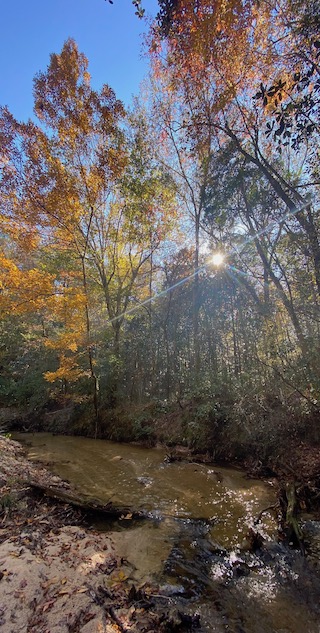
Frequently Asked Questions
Discover answers to pressing questions about the proposed Emerald Coast Motor Club and its potential impact on our community.
Will ECMC bring jobs and tax revenue?
The developer claims $3.6 million in tax revenue and 150–200 jobs, but similar racetrack clubs employ far fewer people, mostly part-time or event-based. Most revenue benefits out-of-county owners and seasonal members, not local families.
How loud will the ECMC racetrack be?
An FIA Grade 2 track supports modified street and professional-level cars exceeding 100+ decibels, plus karting and a skid pad where cars spin, slide, and burn rubber—creating near-constant sound and pollution. A Society of American Engineers study measures db levels of modified street cars in the 100-120db range. This level of noise will travel 2 – 3 miles from the source.
Is the site environmentally sensitive?
Yes. The property contains 25–30% wetlands, lies partly in Flood Zone A, and includes Blount’s Creek, home to protected species. Runoff and pollution will flow into the Choctawhatchee Bay watershed.
Does the project align with local planning standards?
No, we believe the proposed development conflicts with the Walton County Comprehensive Plan, which aims to prevent urban sprawl and overuse of infrastructure, and protect rural landscapes.
Join Us to Protect Our Homes
Together, we can stop this oversized private racetrack and entertainment complex before it reshapes our community forever.
